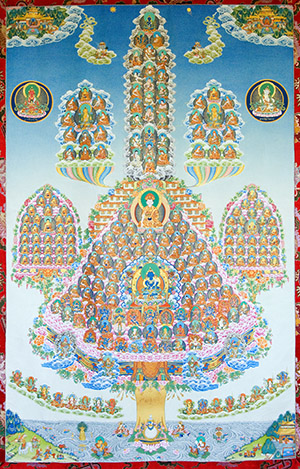The Drikung Kagyu Tradition

The founder of the Kagyu tradition of Tibetan Buddhism was the Mahāsiddha Tilopa (988-1069), who lived in Northern India. He is considered having received a direct transmission from the primordial Buddha Vajradhara. He passed the teachings to his disciple, the Mahāsiddha Nāropa (1016–1100), who in turn transmitted his knowledge to Marpa Chökyi Lodrö (1012–1097), who brought the teachings to Tibet.
Marpa's most important disciple was Jetsun Milarepa (1040-1123). He became one of Tibet's great yogis. One of the main disciples of Milarepa was Gampopa (1079-1153). It is from Gampopa that the first Kagyu schools originated.
Phagmodrupa Dorje Gyalpo (1110–1170) was one of Gampopa’s most important disciples. Phagmodrupa’s Heart Son was Kyobpa Jigten Sumgon (1143-1217) (“Protector of the Three Worlds”). He took over the throne of Phagdru at Densa Thil Monastery for three years after his teacher’s death (1177-1179). In accordance with a prediction of Phagmodrupa he then established his own lineage with the foundation of Drikung Thil Monastery in 1179 in the area of Drikung, the principal monastery of the lineage.
When the Karmapa Dusum Khyenpa (1110–1193), the founder of the Karma Kagyu lineage, came to Drikung Thil, he recognized the entire area as the mandala of Chakrasamvara and saw Jigten Sumgon as the Buddha, and his two main disciples as Shāriputra and Maudgalyāyana, the two main disciples of the Buddha.
Jigten Sumgon attained great fame and people flocked from all parts of the country to receive initiations and teachings from him. He laid particular emphasis on meditative practice. When he was 70 years old, he sent practitioners to three particularly sacred places, in three phases: to Mount Kailash (Gangri Tise), to Mount Lapchi, and to Mount Tsari.
The order grew and spread in the course of time, and Drikung monasteries arose even far away from the main monastery, many of them near Mt. Kailash and over to Ladakh, in Kongpo and above all, in Kham, the founder’s homeland. Jigten Sumgon’s great-grandmother, Achi Chokyi Dolma, had come from Drikung. She had married a yogi from the Kyura Clan in Kham, and had been elevated to the mythical protectress of the order. As was the custom in many schools of Tibetan Buddhism, Jigten Sumgon chose his successor from among his relatives. Thus, initially all but three Drikung Kagyu throne holders came from the Kyura Clan, although there were no set guidelines for the succession among the family members.
Chogyal Rinchen Phuntsog’s (1547-1602) two youngest sons, Gyalwang Konchog Rinchen (1590–1654) and Kunkhyen Rigzin Chodrak (1595–1659) became the last heirs to the throne of Drikung; the Kyura Clan died out with them. Upon the death of Konchog Rinchen the Drikungpa began to seek the reincarnations of their throne holders in the country as a whole. A system of two lineage holders was established, that of the elder (Chetsang) and the younger
Read more comprehensive information about the development of the lineage and about the lineage founder Jigten Sumgon on the Official Website of the Drikung Kagyu Order.